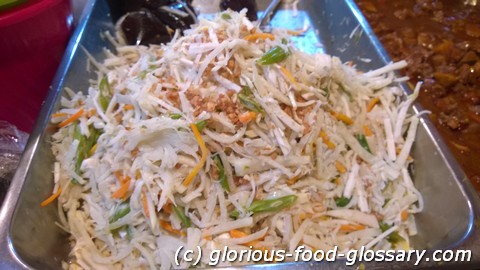Deutsch: Nackte Frühlingsrollen / Español: Rollitos de primavera desnudos / Português: Rolinhos primavera nus / Français: Rouleaux de printemps nus / Italiano: Involtini primavera nudi
Lumpiang Hubad in the food context refers to a Filipino dish that translates to "naked spring rolls." This version of lumpia presents the traditional filling of a spring roll without the wrapping and frying, serving the mixture of vegetables and sometimes meat or seafood directly on a plate or as a salad. The dish usually consists of a variety of stir-fried vegetables such as cabbage, carrots, green beans, and bean sprouts, and it may include ingredients like tofu, shrimp, or ground pork. Lumpiang Hubad is often garnished with crushed peanuts and served with a sweet and savory garlic sauce, making it a lighter, healthier alternative to the traditional fried lumpia.
Description
Lumpiang Hubad showcases the flavors and textures of the lumpia filling in its purest form. By omitting the wrapper and the frying process, the dish focuses on the freshness and vibrancy of the vegetables and the seasoning. It's a popular choice for those seeking a lighter meal or for anyone who enjoys the filling of lumpia but prefers to avoid the additional calories from frying.
Application Areas
Lumpiang Hubad is enjoyed in various settings, including:
- Appetizer or Main Dish: It can serve as a starter or as a light entrée, often accompanied by rice.
- Buffet or Potluck Item: Its easy-to-serve nature makes it a suitable option for buffets and potlucks.
- Health-Conscious Menus: A favorite among those looking for healthier, vegetable-forward options.
Well-Known Examples
While Lumpiang Hubad itself is a specific dish, it shares a connection with other types of lumpia, such as:
- Lumpiang Sariwa: Fresh spring rolls wrapped in a soft, crepe-like wrapper and served with a sweet garlic sauce. Lumpiang Hubad can be considered a deconstructed version of this dish.
- Lumpiang Shanghai: Minced meat and vegetables rolled in thin wrappers and fried, offering a contrast in preparation and presentation to Lumpiang Hubad.
Recipes
A basic recipe for Lumpiang Hubad involves:
-
Ingredients:
- A variety of julienned vegetables (cabbage, carrots, green beans, bean sprouts)
- Optional protein (tofu, shrimp, or ground pork)
- Minced garlic and sliced onions
- Soy sauce or fish sauce for flavoring
- Crushed peanuts and chopped fresh herbs for garnish
- Lumpia sauce for serving (a mixture of water, brown sugar, soy sauce, minced garlic, and cornstarch for thickening)
-
Preparation:
- Stir-fry the garlic and onions in a little oil until fragrant. Add the protein (if using) and cook thoroughly.
- Add the vegetables and stir-fry until just tender. Season with soy sauce or fish sauce.
- Arrange the vegetable and protein mixture on a serving plate. Garnish with crushed peanuts and fresh herbs.
- Serve with lumpia sauce on the side.
Treatment and Risks
Lumpiang Hubad is considered a healthy option due to its emphasis on vegetables and lean proteins. However, when preparing the dish, it's essential to ensure that any meat or seafood ingredients are cooked thoroughly to prevent foodborne illnesses. Additionally, the lumpia sauce should be prepared with care, ensuring it's well-balanced and not too salty.
Similar Terms or Synonyms
- Unwrapped Spring Rolls
- Spring Roll Salad
Summary
Lumpiang Hubad offers a flavorful, nutritious alternative to traditional fried lumpia, focusing on the fresh and vibrant tastes of its vegetable and protein filling. This dish is a testament to the adaptability and health-conscious evolution of Filipino cuisine, providing a delightful way to enjoy the essence of lumpia in a lighter form.
--

Related Articles to the term 'Lumpiang Hubad' | |
| 'Lumpiang Gulay' | ■■■■■■■■■■ |
| Lumpiang Gulay in the food context refers to a Filipino dish consisting of vegetable spring rolls. These . . . Read More | |
| 'Lumpiang Toge' | ■■■■■■■■■ |
| Lumpiang Toge in the food context refers to a Filipino dish consisting of spring rolls filled with mung . . . Read More | |
| 'Pancit Bihon' | ■■■■■ |
| Pancit Bihon in the food context refers to a popular Filipino noodle dish made from bihon (thin rice . . . Read More | |
| 'Lumpiang Shanghai' | ■■■■ |
| Lumpiang Shanghai in the food context refers to a popular Filipino dish consisting of thin, spring roll . . . Read More | |
| 'Toge' | ■■■■ |
| Toge is a Filipino word for Mung Bean Sprouts. Toge is usually or often used in the Philippines as an . . . Read More | |
| 'Corn Kernels Fried Rice' | ■■■ |
| Corn Kernels Fried Rice in the food context refers to a dish that combines cooked rice with corn kernels, . . . Read More | |
| 'Pancit Miki' | ■■■ |
| Pancit Miki is another variant of the broad family of noodle dishes in Filipino cuisine, distinguished . . . Read More | |
| 'Relyenong Pusit' | ■■■ |
| Relyenong Pusit refers to a traditional Filipino dish that consists of stuffed squid. The squid is cleaned . . . Read More | |
| 'Pancit Canton' | ■■■ |
| Pancit Canton is a traditional Filipino noodle dish that is both versatile and beloved across the Philippines. . . . Read More | |
| 'Bubble and Squeak' | ■■■ |
| Bubble and Squeak in Australia, it refers to a dish made by frying leftover meat and vegetables (typically . . . Read More | |
